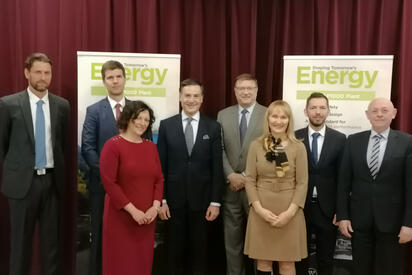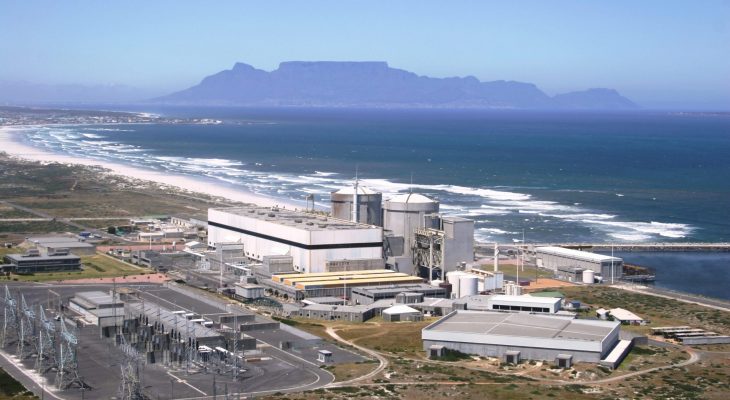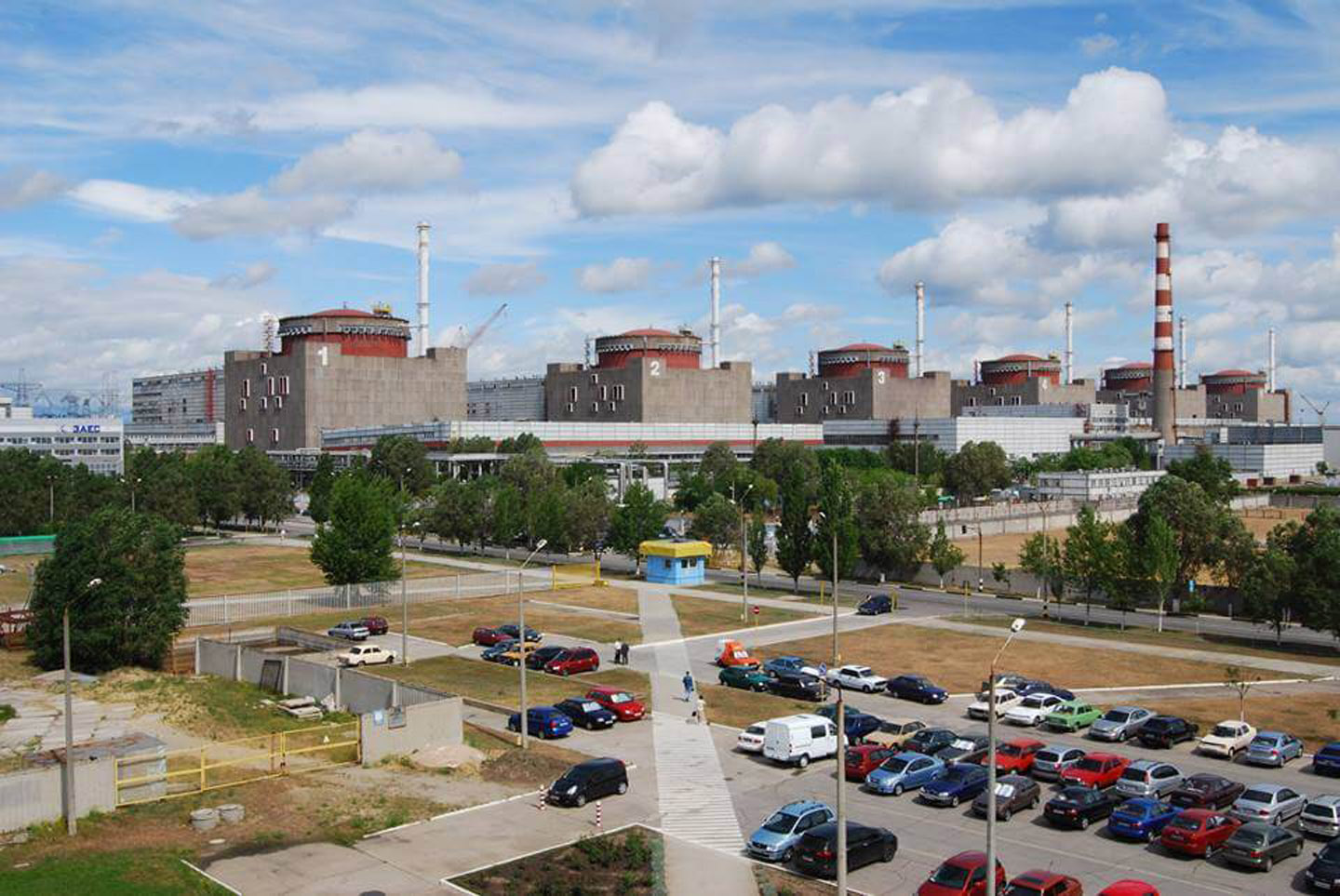Rory O’Sullivan, Moltex Energy’s chief executive officer, North America, speaks at the SNC-Lavalin/Moltex partnership announcement ceremony at CNA2022.
SNC-Lavalin and Moltex Energy are partnering to advance the development and deployment of small modular reactor technology in Canada, the companies announced last week at the Canadian Nuclear Association’s 2022 conference in Ottawa, Ontario. The partnership will support Moltex as it pursues the licensing and construction of its 300-MW Stable Salt Reactor–Wasteburner (SSR-W), a molten salt reactor that uses nuclear waste as fuel.
The Project Pele microreactor will be fueled by TRISO fuel particles like those shown here. (Photo: INL)
The Diablo Canyon nuclear power plant. (Photo: Doc Searls)
Officials in California are planning to replace the electricity produced by the Diablo Canyon nuclear power plant, scheduled to shut down in 2025, “mostly with Wyoming coal-fired generation.” That claim is made in a post on the Capitol Weekly website written by Gene Nelson, a cofounder of Californians for Green Nuclear Power (CGNP). Nelson writes that although state officials are trying to hide this plan from the public, CGNP uncovered it by detecting four obscure clues in California Public Utilities Commission (CPUC) filings.
Ontario clean energy leaders. From left: John Gorman, president and chief executive officer of the Canadian Nuclear Association; Ken Hartwick, president and CEO of Ontario Power Generation; Todd Smith, Ontario’s minister of energy; and Mike Rencheck, Bruce Power president and CEO. (Photo: Bruce Power)
Bruce Power and Ontario Power Generation (OPG) have announced an agreement to work together to support new nuclear technologies in Ontario. Bruce Power operates the Bruce nuclear plant and OPG operates the Darlington and Pickering facilities.
Attending the MOU signing on April 5 are, from left, Franc Škrabec, Numip, nuclear power program manager; Tine Ogorevc, Numip, general manager; Josefa Arcarons Coma, Westinghouse, global supply chain manager for the Europe, Middle East, and Africa region; Elias Gedeon, Westinghouse, senior vice president of commercial operations; Joel Eacker, Westinghouse, vice president of new power plant projects; Mojca Lorber, Sipro Engineering, commercial manager; Metod Pirc, Elmont, general manager; and Franc Katič, Sipro Engineering, general manager. (Photo: Westinghouse)
Westinghouse’s plans for supplying AP1000 reactors to Ukraine may have been complicated by Russia’s invasion of the country, but the company is nonetheless continuing its efforts to strengthen business ties in Central and Eastern Europe. On April 5, Westinghouse signed memorandums of understanding with three companies in Slovenia.
Energy Harbor’s Perry nuclear power plant, in Perry, Ohio. The company says its nuclear units are “critical infrastructure required for the U.S. clean energy transition.”
Energy Harbor—owner and operator of the Beaver Valley, Davis-Besse, and Perry nuclear power plants—recently announced its plan to become a carbon-free energy infrastructure and supply firm in 2023. Energy Harbor is based in Akron, Ohio.
The Diablo Canyon nuclear power plant, located near Avila Beach, Calif.
A recent article on a radio station website about an auxiliary feedwater (AFW) pump problem at the Diablo Canyon nuclear power plant led to information exchanges between a reporter, the American Nuclear Society, and nuclear advocates. The incident also involved a tweet by a member of the Union of Concerned Scientists.
The Koeberg nuclear power plant, near Cape Town, South Africa. (Photo: Eskom)
An International Atomic Energy Agency team of experts has completed its review of the long-term operational safety of South Africa’s Koeberg nuclear power plant, which is operated by the public utility Eskom.
The New Safe Confinement structure over the damaged fourth reactor at the Chernobyl nuclear power plant. Photo from 2018.
Ukraine’s nuclear operator, Energoatom, announced yesterday that the Russian military has withdrawn from the Chernobyl plant and surrounding area. “According to the staff of the Chernobyl nuclear power plant, there are now no outsiders on-site,” Energoatom stated in an online post. Russian forces took control of Chernobyl on February 24, day one of the invasion.
In a separate post, the company said that the Russians had formally agreed to return the responsibility for Chernobyl to Ukraine. It shared a scan of a document, with the heading “Act of acceptance and transfer of protection of the Chernobyl nuclear plant,” purportedly signed by a representative of Russia’s National Guard, a representative of Rosatom, Russia’s state atomic energy corporation, and a Chernobyl plant shift manager.
March 30, 2022, 11:55AMANS Nuclear CafeJacopo Buongiorno, Steven Nesbit, Malcolm Grimston, Lake Barrett, Matthew L. Wald, and Andrew Whittaker The six reactors at the Zaporizhzhia nuclear power plant in southeastern Ukraine.
On March 4, Russian forces set fire to an office building at Ukraine’s Zaporizhzhia nuclear power plant, raising fears about reactors being damaged. The attack stirred up memories of the Chernobyl accident in 1986, a reaction that longtime nuclear opponents are taking advantage of to rekindle their cause. However, the reactors operating in Ukraine today are profoundly different from the design used at Chernobyl, and are, by nature, difficult to damage.
Let’s set the record straight and explain the risks of nuclear power plants in war zones.
The Fuqing nuclear power plant. (Image: CNNC)
The Fuqing nuclear plant’s Unit 6, one of two Chinese-designed and -developed Hualong One reactors at the site, has entered commercial operation, China National Nuclear Corporation (CNNC) announced on March 25. The milestone was reached some 14 months after the reactor’s twin, Fuqing-5, became the first Hualong One in the world to enter commercial operation.
Also known as the HPR1000, the Hualong One is a 1,000-MWe Generation III pressurized water reactor that incorporates design elements of CNNC’s ACP1000 and China General Nuclear Power Group’s ACPR1000+.
Data from research firm PitchBook show a spike in nuclear investment. (Graph: Bloomberg)
The trend of big-tech billionaires of Silicon Valley investing in next-generation nuclear energy startup companies continues. In a March 22 article on the Bloomberg website, Lizette Chapman, of the site’s venture capital group, writes that these investors view nuclear power as “a solution to both cutting carbon emissions and weaning the world off now-controversial Russian gas.”
Unit 2 at the UAE’s Barakah nuclear plant. (Photo: ENEC)
Unit 2 at the United Arab Emirates’ Barakah nuclear power plant has entered commercial operation, Emirates Nuclear Energy Corporation (ENEC) announced on March 24. Unit 2 adds an additional 1,400 MW of zero-carbon emission electricity to the UAE’s national grid, bringing the total amount of electricity produced at Barakah to 2,800 MW.










,_July_2020.jpg)
 The Nuclear Regulatory Commission yesterday unveiled its
The Nuclear Regulatory Commission yesterday unveiled its 




 The governments of four Canadian provinces—Ontario, New Brunswick, Saskatchewan, and Alberta—have published a plan outlining the path forward for the advancement of small modular reactors, which could provide the nation with safe, reliable, and zero-emissions energy and create new export opportunities.
The governments of four Canadian provinces—Ontario, New Brunswick, Saskatchewan, and Alberta—have published a plan outlining the path forward for the advancement of small modular reactors, which could provide the nation with safe, reliable, and zero-emissions energy and create new export opportunities.


